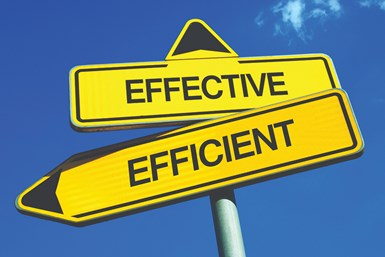The Battle for Performance: Efficiency Versus Effectiveness
Does your daily activity have anything to do with your effectiveness? The answer may surprise you.
#pmpa
There is a battle going on in your shop. You may not realize it, but it happens every day. It is the battle between efficiency versus effectiveness.
I know some of you are saying to yourselves “efficiency and effectiveness are the same thing, right?” Well, let’s define them and find out.
Featured Content
The American Dictionary defines, effectiveness as “the ability to be successful and produce the intended results.” According to Merriam-Webster.com, efficiency is defined as “what is capable of producing desired results without wasting materials, time, or energy.”
Now we can see the true difference. Efficiency is doing something using the least amount of time — producing the items with the least number of inputs to achieve the output. Effectiveness is producing the intended, the desired result. We can produce parts at five seconds for hours, but if they don’t hold tolerance, we are not being effective. We are efficient with our fast cycle time, but not achieving effectiveness. Our customers only pay for effectiveness. Effectiveness is our parts that meet dimensional tolerances in the box ready to go to the customer.
I think we get lost in our quest for lowest cycle times — which we think of as being efficient and sometimes miss the mark on effectiveness. We strive to get the fastest cycle time possible. What happens when our performers must stick their head in a machine every 10 minutes to change an insert? Yes, it is running in 10 seconds, but it is down 50% of the time because of the increased downtime for tool changes. What if we adjust our feeds and speeds a little, take it down to 15 seconds and the job runs all night? Yes, 15 seconds is technically 50% less efficient, but now we get 90% production and can run 10 hours unattended. Which machine has more parts produced by tomorrow morning? The machine with the performer tinkering every 10 minutes, or the machine running all night?
We need to learn to be effective with our efficiency for the right things. This idea is very similar to Jim Collins’ Good to Great bus example. We must get the right people on the bus, then make sure all the people are in the right seats on the bus to succeed. In our shop processes, we must do the right things. Then we must become very efficient at doing those things. The challenge is to start with yourself. At the end of every day for a week, sit down and make a list of everything you accomplished. At the end of the week, mark which activities you did that were effective. You may be surprised at how much activity you do every day that has nothing to do with your effectiveness. After you see the waste in your personal effectiveness, start to look at the waste in the shop. We want to do those things that matter. We want our performers working effectively at all times. Granted, 100% effectiveness is not achievable, but like a true north vision, it gives you direction.
To be effective is to have the most compliant parts in the bucket at the end of 24 hours. (Or to have completed the most meaningful work.) Effectiveness is the long-term view. Trying to accomplish tasks purely based on efficiency shifts our focus from quality to time savings. This is a shortsighted approach to mistakenly maximize our here-and-now. But our true goal for our organization is long-term success. To be truly effective is to be efficient in the right things. Are you efficient in the right things? At the end of the day, did you get the most parts in your bucket?
About the Author
David Wynn
David Wynn, MBA, is the PMPA Technical Services Manager with over 20 years of experience in the areas of manufacturing, quality, ownership, IT and economics. Email: dwynn@pmpa.org — Website: pmpa.org.
RELATED CONTENT
-
Educational Offerings at PMTS
Technical presentations and on-the-show-floor, booth demonstrations can lead you to discover new ideas to help your shop become more efficient and profitable.
-
Reaming as an Alternative to Single-Point Boring
Using slip yokes as an example, reaming through holes can be more efficient and effective than single-point boring operations.
-
10 Ways AI Might Impact Manufacturers
Artificial intelligence offers the promise of assisting decision-making processes and boost overall manufacturing efficiency.







